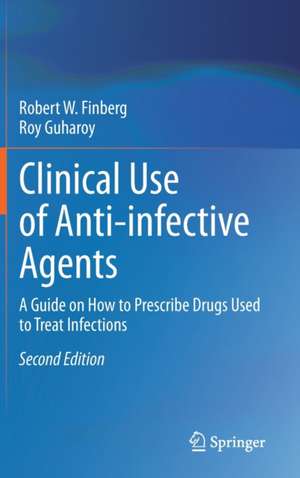Clinical Use of Anti-infective Agents: A Guide on How to Prescribe Drugs Used to Treat Infections
Autor Robert W. Finberg, Roy Guharoyen Limba Engleză Hardback – 24 iul 2021
Each section includes references allowing for in-depth study of specific agents, Q&As, and illustrative case studies accompanied by commentary on how to approach patients and organisms, optimal methods of making a diagnosis, and prescribing treatment.
| Toate formatele și edițiile | Preț | Express |
|---|---|---|
| Hardback (2) | 717.20 lei 6-8 săpt. | |
| Springer – 16 ian 2012 | 717.20 lei 6-8 săpt. | |
| Springer International Publishing – 24 iul 2021 | 786.86 lei 6-8 săpt. |
Preț: 786.86 lei
Preț vechi: 828.27 lei
-5% Nou
Puncte Express: 1180
Preț estimativ în valută:
150.56€ • 157.20$ • 124.61£
150.56€ • 157.20$ • 124.61£
Carte tipărită la comandă
Livrare economică 05-19 aprilie
Preluare comenzi: 021 569.72.76
Specificații
ISBN-13: 9783030674588
ISBN-10: 3030674584
Ilustrații: XIV, 300 p. 82 illus., 2 illus. in color.
Dimensiuni: 155 x 235 mm
Greutate: 0.62 kg
Ediția:2nd ed. 2021
Editura: Springer International Publishing
Colecția Springer
Locul publicării:Cham, Switzerland
ISBN-10: 3030674584
Ilustrații: XIV, 300 p. 82 illus., 2 illus. in color.
Dimensiuni: 155 x 235 mm
Greutate: 0.62 kg
Ediția:2nd ed. 2021
Editura: Springer International Publishing
Colecția Springer
Locul publicării:Cham, Switzerland
Cuprins
1. Introduction and history.- 2. Basic principles of drug delivery and dosing.- 3. Sulfonamides.- 4. Penicillins.- 5. Cephalosporins.- 6. Monobactams: Aztreonam.- 7. Carbapenems.- 8. Glycopeptides and other agents used to treat gram-positive cocci.- 9. Vancomycin: New Area-under-the-curve-based therapeutic monitoring.- 10. Aminoglycosides.- 11. Macrolides.- 12. Metronidazole and clindamycin.- 13. Quinolones.- 14. Tetracyclines.- 15. Pleuromutilin.- 16. Antimicrobial stewardship: evolution into the 21st century.- 17. Clinical approach to the treatment of infectious diseases.- 18. Understanding drug allergies and drug toxicities.- 19. Antibiotic-associated diarrhea.- 20. Principles of antibiotic resistance.- 21. Clinical approach to treatment of bacterial infections.- 22. Clinical approach to treatment of mycobacterial infections.- 23. Clinical approach to treatment of fungal infections.- 24. Clinical approach to treatment of viral infections.- 25. Sample cases and analyses of the use ofanti-infective agents: Cases 1-15.- Appx A. Common infectious diseases and empiric antibiotic recommendations for adult ed and inpatients at UMass Memorial Medical Center.- Appx B. Bioavailability of anti-infective agents.- Appx C. Dosage and intervals for administration of IV antimicrobials.- Appx D. Dosage and intervals for administration of oral antimicrobials.- Appx E. Important interactions with commonly-used anti-infectives.- Appx F. Oral agents that may have interactions with food.- Appx G. Drug interactions with anti-retroviral agents.- Appx H. Dosage in obesity.- Appx I. Recommendations for management of Asymptomatic Bacteriuria (ASB): 2019 update.- Appx J. Guidelines for treatment of C. difficile.- Appx K. Antimicrobial prophylaxis for adult patients with cancer-related immunosuppression.- Appx L. Guidelines for treatment of adults with community-acquired pneumonia.- Appx M. Guidelines for management of adults with hospital-acquired and ventilator-associated pneumonia.- AppxN. Guidelines for antimicrobial prophylaxis for surgery.- Appx O. Guidelines for treatment and chemoprophylaxis of influenza.- Appx P. Antimicrobial dosing in adult patients on extracorporeal membrane oxygenation (EXMO).- Appx Q. Antimicrobial dosing in neonates.
Notă biografică
Robert W. Finberg
Richard Haidack Professor and Chair
Department of Medicine
University of Massachusetts
Medical School
Worcester, MA, USA
Robert.Finberg@umassmed.edu
Robert.Finberg@umassmed.edu
Roy Guharoy
System Vice President
Baptist Health System, Montgomery, AL
UMass Memorial Health Care Clinical Professor of Medicine
University of Massachusetts
Medical School
Worcester, MA, USA
Roy.Guharoy@umassmemorial.org
Textul de pe ultima copertă
This second edition of Clinical Use of Anti-Infective Agents provides a comprehensive overview of current approaches to using drugs to treat infections, including historical perspectives, definitions, and discussion of pharmacokinetics and pharmacodynamics and their uses. It includes a detailed explanation of different classes of drugs, outlining their spectrum, pharmacokinetics, side effects, and dosing in clinical settings. This book has been designed as a reference tool for pharmacists, clinicians, nurse practitioners, and clinical microbiologists, as well as a teaching vehicle for students studying infection and patient treatment.
Each section includes references allowing for in-depth study of specific agents, Q&As, and illustrative case studies accompanied by commentary on how to approach patients and organisms, optimal methods of making a diagnosis, and prescribing treatment.
Each section includes references allowing for in-depth study of specific agents, Q&As, and illustrative case studies accompanied by commentary on how to approach patients and organisms, optimal methods of making a diagnosis, and prescribing treatment.
Caracteristici
Designed as a teaching vehicle for pharmacy, nursing, physician assistant, medical students and clinical practitioners Provides a quick-reference guide for pharmacists, nurse practitioners, and clinical microbiologists Features illustrative case studies, commentary, and study questions
Descriere
Descriere de la o altă ediție sau format:
Starting with an outline of the drugs used to treat infections, this book then analyzes approaches to diseases caused by different organisms (bacteria, fungi, and viruses). It also sets out numerous case studies, dosing recommendations and drug interactions.
Starting with an outline of the drugs used to treat infections, this book then analyzes approaches to diseases caused by different organisms (bacteria, fungi, and viruses). It also sets out numerous case studies, dosing recommendations and drug interactions.
